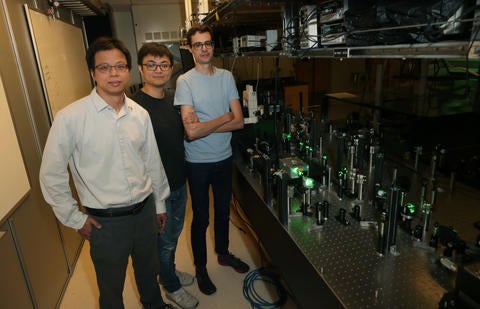An international research team led by physicists at the University of California, Riverside, has revealed a new quantum process in valleytronics that can speed up the development of this fairly new technology.
Valleytronics, a portmanteau of “valley” and “electronics,” uses local energy minima — or valleys — in the electronic band structure of semiconductors. Current semiconductor technology uses electronic charge or spin to store and process information. In some semiconductors, however, valleys of the electrons are used to encode, process, and store information. Valleytronic systems have the potential to offer information processing schemes that are superior to charge- and spin-based semiconductor technologies.

The UC Riverside-led research team focused on monolayer tungsten diselenide (WSe2), a two-dimensional semiconductor with two distinct electronic valleys. Excited electrons tend to relax and accumulate in one of the valleys to acquire a valley index (K or K’). The valley indices can be used to represent 1 and 0 to encode information — just as electric charge is used in current technology.
Excitons and trions can also occupy the valleys in monolayer WSe2 and be used to transmit valley information. An exciton is a quantum bound state of an electron and an electron hole. A trion is a quantum bound state of three charged particles. Monolayer WSe2 hosts bright and dark excitons or trions with different spin configurations; bright decay rapidly into light, while dark decay slowly into light.
“Development of valleytronics requires stable valley states and easy identification of the valley indices,” said Chun Hung “Joshua” Lui, an assistant professor in the Department of Physics and Astronomy at UC Riverside, who led the research. “Dark excitons and trions in monolayer WSe2 have much longer lifetime and better valley stability than the common bright excitons and trions. The dark excitons and trions, therefore, serve as excellent candidates for valleytronic applications.”
Lui explained that until now no method could read the valley indices of the dark excitons and trions because their light emission from either valley has exactly the same energy and polarization, making the two valleys indistinguishable from each other. Lui’s research team has now overcome this obstacle by identifying a measurable physical quantity that can distinguish the two valley indices of dark excitons and trions.
“We observed a new decay process of dark excitons and trions in monolayer WSe2, which allows us to identify their valley indices,” Lui said. “A dark exciton or trion can decay into a pair of photon and phonon with a distinctive valley signature.”
A photon is a quantum of an electromagnetic wave. It can have linear or chiral polarization when the electromagnetic field oscillates or rotates. The rotational direction of the electromagnetic field determines whether a chiral photon is right-handed or left-handed. Similarly, a phonon is a quantum of atomic vibration in the material. Atomic vibration usually involves linear oscillation of atoms. But in some special cases, the atoms can rotate to produce the so-called chiral phonons. The atomic rotation direction determines whether a chiral phonon is right-handed or left-handed.
“We found that the dark exciton in the K valley decays into a right-handed photon and a left-handed phonon, whereas the dark exciton in the opposite K’ valley decays into a left-handed photon and a right-handed phonon,” Lui said. “The handedness of the emitted photon is a clear signature of the valley indices of the dark excitons and trions.”
Lui added that the ability to read the dark-state valleys could facilitate the exploration of dark-state valley dynamics and applications in valleytronic technology.
The study appears in Physical Review Research, an open-access journal.
Lui was joined in the study by Erfu Liu, a postdoctoral researcher in Lui’s lab and the first author of the research paper, and graduate student Jeremiah van Baren of UC Riverside; Takeshi Taniguchi and Kenji Watanabe of the National Institute for Materials Science, Japan; and Yia-Chung Chang of the Research Center for Applied Sciences, Academia Sinica, Taiwan.
Header image caption: A dark exciton (light blue) in monolayer WSe2 is found to decay into light (red) and atomic vibrations (blue) with opposite circular polarization. Credit: Erfu Liu, UC Riverside.